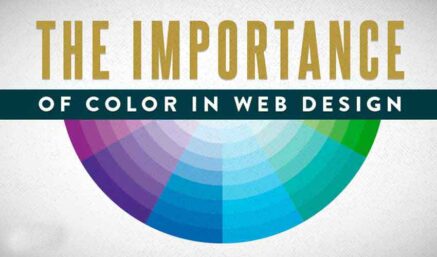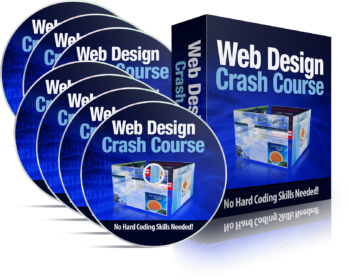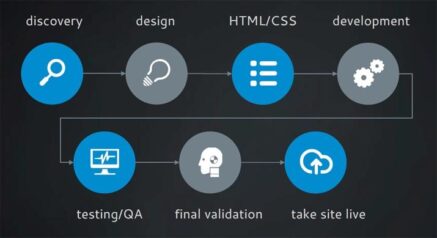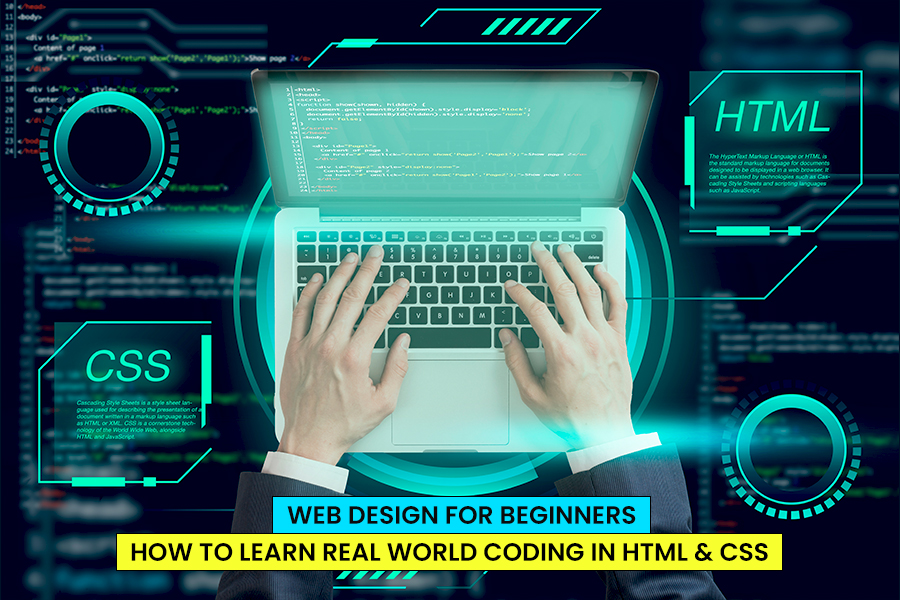
With the growing need for appealing websites in this digital age, a career in web design sounds promising.
Website design is an essential aspect of the web development process. It builds the perfect visual appeal, makes the presence credible and attracts potential customers. Therefore, qualified web designers are crucial to functional website design.
So, how to become a web designer in 2024?
Web design for beginners can be intimidating. However, kickstarting a career with the right design skills and technical understanding is easy. A web design course for beginners is an impressive place to begin.
The courses entail the fundamentals of web design, HTML, CSS and the foundation of an effective UI/UX. HTML, CSS, and UI/UX design must amalgamate effectively for any web presence to be functional, responsive, and user-friendly. A structured web design course covers the foundational concepts of each to help beginners become efficient web designers.
This meticulous read explores the basics of a web design course with HTML & CSS. We will also learn real-world coding strategies that supercharge the web design career. Let us begin!
Getting Started with Web Design and its Fundamentals
Before you start a career in web designing as a beginner, it is vital to understand the basics of web designing and what it entails. While it may all sound creative, multiple technicalities and analytics come into play in website design.
Before enrolling in a web designing course, let us delve deeper into the fundamentals.
What is Web Design?
In simple terms, web design refers to a web presence’s design and visual structure. It encompasses planning the website structure and content to effectively reflect the brand image. Several design aspects come into play: font, imagery, graphics, and interface. Additionally, there are other usability factors like navigation, layout, header, footer, and typography.
The design elements function together to improve the web design engagement aspects and user experience.
Why Learn HTML and CSS?
If you are wondering what the function of web design with HTML & CSS is, this section thoroughly explains your queries.
HTML or Hypertext Markup Language is a design language web design professionals use to structure their websites. HTML code forms the backbone of web pages and allows search engines to render them effectively.
All the design elements – from visual aspects to decipherable content – are defined by HTML tags. It makes the web presence structured, accessible and responsive to offer the ultimate user experience.
HTML and CSS go hand-in-hand when it comes to web designing. CSS, or Cascading Style Sheets, is a markup language that complements the HTML code and makes it visually presentable. It helps designers separate the design from the website layout and control the elements. Designers can choose to enhance the design flexibility and maintain a consistent presence.
As a web designer aspirant, you must understand the importance of CSS and HTML in web design.
Common Misconceptions about Web Design
The internet is a den of information and misinformation for beginners. Search for website design, and you will come across contradictory information. As candidates willing to join the web design industry believe, it is essential to differentiate web design myths from truths.
- Website design is not about making a web presence pretty. It focuses on the aesthetics of the presence, including the user experience, usability, and overall impact of the design elements. No matter how pretty a website is, if the web design aesthetics do not align with the brand, it fails to attract the target audience.
- Website design is way beyond a one-and-done process. It is ongoing and requires adept hands to stay relevant and competitive. The design requires steady updates, maintenance and optimisation to keep up with the evolving technologies and user expectations.
- Not all web designs or designers are the same. Each designer’s style, skills, and branding philosophy vary. As a beginner, learning web design philosophies aligned with a brand image is essential.
- Modern website designs are not always the best options. Web designs vary and must align with the brand. They include colour theory, font essentials, etc., and deliver a consistent brand story. Whether you choose a modern or traditional web design, it must convey the right message and engage the target audience appropriately.
These are some of the most common misconceptions about website design. Before enrolling in a web design course, it is essential to learn the realities of web design and its impact on the digital domain.
Introduction to HTML
HTML or Hypertext Markup Language is the standard language to develop web pages. It helps structure the website and work around the sections and paragraphs of the web content. The building blocks of the web page can be formed with HTML elements such as tags and attributes.
HTML has primary functions such as development, navigation, and documentation.
The HTML code determines how the website is displayed across search engines, especially the design elements like links, hyperlinks and media.
In navigation, the HTML code allows linking related pages using hyperlinks. It leads the users towards a desired action and elevates user experience.
HTML also helps organise and format documentation, similar to Microsoft Word and makes it easy for web designers to structure their presence accordingly.
Understanding HTML Structure
The HTML structure is divided into five elements, and each plays a distinctive role in creating an impactful web design –
- <!DOCTYPE> – It informs the web browser about the HTML version and is referred to as Document Type Declaration (DTD).
- <html> – This HTML tag is utilised to specify HTML and XHTML roots. It serves as a secondary container for the HTML document.
- <head> – The head tag, used after the html tag, contains the metadata. The type and amount of the data may vary for website designs. Information about the web presence, like the character set, style, and links, are defined within the metadata.
- <title> – The title tag holds the name of the web page and is relevant to the entire HTML content. While the title can be anything, the most appropriate one will help achieve organic ranking. Businesses utilising the website can incorporate essential keywords and create an optimised presence.
- <body> – The body encompasses the primary web page content. It includes texts, paragraphs, links, videos, imagery and more.
These are essential elements of the HTML structure and typical of every website. Every web designer must include these elements to define the site’s structure.
Basic HTML Tags and Elements
Apart from the fundamental structure elements like head, body and title, HTML offers a package of other tags and elements to help form the web design. The curriculum will cover all the basic tags and elements when learning real-world coding in a web design course. These must be included to create a highly functional and engaging web design.
Here are the additional HTML tags and elements you need to know while in a web design course for beginners –
- <h1> to <h6>: These heading elements are used to define different levels’ headings. <h1> is the top-level heading of a web page, while <h6> is the lowest level.
- <p>: Paragraph element, used to define paragraphs of text. These are utilised across the web to place relatable yet generic content.
- <a>: Anchor element creates hyperlinks to other web pages, files, or locations within the same page. It helps in the intuitive experience of the users and influences the traffic flow.
- <img>: This HTML image element helps embed images into the web page.
- <ul>: Unordered list element to create a bulleted list of items.
- <ol>: Ordered list element to create a numbered list of items.
- <li>: List item element is used within `<ul>` or `<ol>` to define individual items in a list.
- <div>: The division element groups and styles content within a document.
- <span>: Inline division element helps apply styles or manipulate text within a document without affecting the structure.
- <br>: Line break element creates a forced line break within the text.
- <hr>: Horizontal rule element creates a thematic break or divider within the content.
These are just a few of the most commonly used HTML tags and elements. During the learning phase, understand how to use and combine them effectively. These are essential to creating well-structured and semantically meaningful web pages.
Always select a reputable organisation to learn web design. Their courses are mentored by industry experts who know how to use HTML elements and tags to create responsive web designs.
How to Create Your First HTML Document?
If you are sceptical about web design, we can help you gain some confidence. Let us create your first HTML document.
Here are some simple steps to write an HTML document –
- Open a Text Editor like Notepad or TextEdit, depending on the device.
- Begin the HTML document by declaring the document type. Type <!DOCTYPE html> at the very top of the document. It tells the browser that you are using HTML5, the latest version of HTML.
- Start writing the HTML structure as we discussed earlier. The format goes like this –
<html>
<head>
<title>Your Title Here</title>
</head>
<body>
<h1>Hello, World!</h1>
<p>This is my first HTML document.</p>
</body>
</html>
Depending on the web page type, add the desirable titles and headings. The title tag text appears in the browser’s title bar.
Alternatively, add relatable content within the body tag. The H1 will be the heading; there can be only one heading on a web page. The <p> tag holds the paragraph content.
- Save your document with an appropriate filename and the `.html` extension. For instance, you can name it `test.html`.
- Double-click the HTML file in a web browser to open it. You will be able to view the document as a web page.
Viola! You just created your first HTML document. Wasn’t that easy?
In a web design course, you will learn to create more complex web pages with additional elements and incorporate CSS to make the design more interactive.
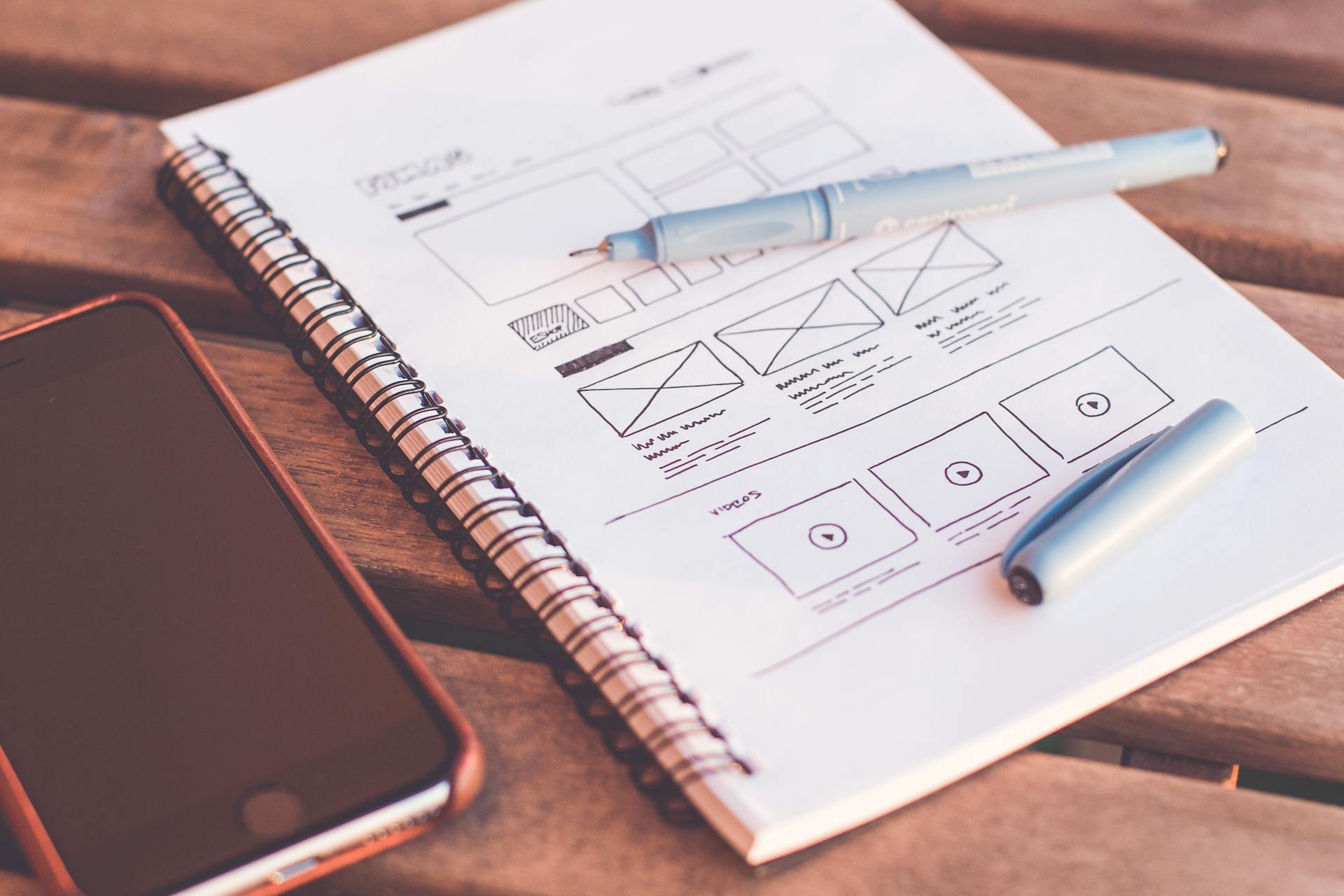
Best Practices for Writing Clean HTML Code
Whether you are a beginner in a web design course or a seasoned individual brushing up your skills, following the HTML best practices to stay aligned with the web design principles is essential.
Additionally, writing clean and well-structured HTML code improves the readability of web pages, making them more maintainable and accessible.
Here are some best practices to follow as suggested by industry experts –
1. Use Semantic HTML
Use HTML elements that are relatable to the content. For instance, ‘<header>’ for the header section, ‘<nav>’ for navigation menus, etc.
Semantic HTML enhances accessibility and organic visibility.
2. Indentation and Formatting
Indent the code effectively to reflect the structure of the HTML document. Use consistent spacing and formatting to make your code easier to read and understand.
3. Use Lowercase
HTML is case-insensitive, but the best practice is to use lowercase letters for tags and attributes. It improves consistency and readability.
4. Provide Comments
Add comments to the code to explain the purpose or to provide context for other developers who may work on the project. The comments must be concise, decipherable and relevant.
5. Separate Structure from Presentation
Avoid inline styles. Use external CSS files to define the presentation of the HTML elements. The separation improves maintainability and allows easy updates of the visual design.
6. Optimise for Accessibility
Ensure the HTML code is accessible to all users, including those with disabilities. Use appropriate ARIA or Accessible Rich Internet Applications attributes, provide alternative text for images and navigable content with keyboard-only input.
7. Use Valid HTML code
Validate the HTML code using W3C Markup Validation Service or to ensure it adheres to the HTML specifications. Valid HTML reduces rendering issues and improves cross-browser compatibility.
8. Avoid Deprecated Elements and Attributes
Stay updated with the latest HTML standards; avoid using deprecated elements or attributes. Deprecated features become obsolete in future versions of HTML and cause compatibility concerns.
9. Test Across Different Browsers
Test the code across web browsers to ensure consistent rendering and functionality. Different browsers interpret HTML code differently; therefore, it is essential to check for compatibility.
Learning web design best practices is essential to staying ahead in future, real-life projects.
A reputable and structured course ensures candidates are aware of the minute design principles and practices. This quality is necessary to get hired and thrive in the competitive digital realm.
Introduction to CSS
Learning HTML is excellent, but web design can only go further with CSS. Cascading Style Sheets (CSS) are an essential component of web design. They allow you to control the visual presentation of HTML documents. CSS contributes to how users engage with and experience the web presence.
We will delve into what CSS is and how its syntax works. We will also explore applying styles to HTML elements and creating a consistent presence using selectors and properties.
CSS is a style sheet language utilised to format the HTML document. It separates the content from its presentation. It enables web designers to apply styles consistently across multiple pages.
There are processes to define rules for how the HTML elements must be displayed. CSS empowers designers to create visually appealing and user-friendly websites.
Understanding CSS Syntax
CSS and HTML function together to make a website functional and appealing. However, the HTML document must be in place for CSS to work.
CSS syntax entails selectors and declarations. Selectors target specific HTML elements, like the heading or the title, and the declarations define the style rules for the selected elements.
A declaration consists of a property and corresponding value, separated by a colon and enclosed within curly braces. For instance –
selector { property: value;}
While in the code, it can look like this – h1 {colour: blue;}
This changes the header text to a blue colour.
Selectors can be simple, targeting specific elements like paragraphs or headings, or they can be more complex, utilising classes, IDs, or hierarchical relationships. Either way, selectors help pinpoint elements within the HTML document seamlessly.
CSS properties dictate the visual characteristics of elements. From setting the background colour to defining the width and height of elements, CSS properties offer a wide range of options to customise the appearance of your webpage.
Creating Stylish Web Designs with CSS
With CSS, candidates can go highly creative and develop visually striking websites. By combining different selectors, properties, and values, they can craft layouts, add animations, and create responsive designs.
When working on a real-life project, it is essential to study the brand and the target audience to deliver a tailored web design. A custom website design elevates user experience and appeal.
Whether aiming for a sleek and modern web design or a colourful aesthetic, CSS provides the ideal tools to bring the vision to life.
CSS is a powerful tool for every aspiring web designer, and a structured course helps them master it. By understanding its syntax, selectors, properties, and how to apply styles to HTML elements, learners will be well-equipped to create professional-looking websites that engage and delight users.
During the web design course, pay attention to all the intricacies of CSS and HTML to unlock the endless possibilities of the web design domain.

Learning Real-World Coding Techniques in a Web Designing Course
As a beginner web design enthusiast, you may need to learn how experts use real-world coding techniques to blend CSS and HTML into modern designs. These designs are responsive and intuitive and make the website engaging.
Let us explore some techniques web designers use to build dynamic and user-friendly web experiences.
1. Designing Responsive Layouts with CSS Grid and Flexbox
CSS Grid provides a two-dimensional layout system. It allows designers to create complex layouts with rows and columns. With grid containers and items, experts can control the placement and alignment of elements on the web page.
CSS Grid helps create grid-based designs like magazine-style layouts or card-based interfaces.
Flexbox or Flexible Box Layout is a one-dimensional model that efficiently distributes space among items in a container. Designers can easily align, distribute, and reorder elements within a container. It is ideal for building responsive navigation menus, flexible content sections, etc.
Responsive layouts adapt seamlessly to different screen sizes and devices. They provide users with a consistent and intuitive browsing experience across desktops, tablets, and Smartphones.
2. Incorporating Multimedia in Web Design
Multimedia elements such as images, videos, and audio are essential for crafting enriched content. The elements help engage users through audio and visuals.
Designers use the `<img>` element to incorporate images into a web page and specify the image source (`src`). There are optional attributes such as `alt` text for accessibility and `width` and `height` for sizing.
Embedding videos is achieved by the `<video>` element. It lets designers specify the video source with `src`, dimensions, controls, and other custom attributes.
Similarly, audio files are embedded with the `<audio>` element and provide controls for playback, volume, and others.
Multimedia content helps enhance the visual appeal and interactivity of web pages. It keeps users engaged and entertained and leads them to conversion.
3. Implementing Navigation Menus and Links
Navigation menus and links enable users to navigate between different pages and sections of a website.
The HTML listing elements <ul> and <li> combined with CSS styling help create navigation menus. Additionally, CSS techniques such as floats, Flexbox, or CSS Grid create horizontal or vertical navigation menus that are responsive and visually appealing.
Hyperlinks using the <a> element create clickable links within web pages. It allows users to navigate to other pages or specific sections within the same page. The link styles can be customised using CSS to ensure consistency and usability throughout the website.
4. Enhancing User Experience with Forms and Fields
Forms and input fields enable user interaction and information collection. User-friendly and accessible forms encourage engagement and minimise friction.
HTML provides a range of form elements such as text inputs, checkboxes, dropdown menus, and more. Designers can structure forms using HTML form elements and customise the appearance and behaviour using CSS.
5. JavaScript and Web Design
JavaScript is a versatile programming language that adds interactivity and dynamic behaviour to a web design. The language adds functionality and interactive elements. Additionally, it manipulates the DOM (Document Object Model) and handles multiple user events in a web presence.
JavaScript allows designers to dynamically update content on web pages without reloading the entire page, creating a smoother and more responsive user experience. AJAX (Asynchronous JavaScript and XML) enables designers to fetch and display data from servers without interrupting the user workflow.
The programming language provides APIs for manipulating the DOM, allowing designers to create, modify, and remove HTML elements dynamically.
By learning JavaScript, web design aspirants can unlock a new level of creativity and interactivity in website design. The entire learning curriculum empowers them to create engaging and immersive user experiences.
These strategies are time-tested and real-life examples of utilising HTML, CSS and JavaScript during web design. If you are enrolling in a web design course for beginners, discuss the learning program and the curriculum details before committing.
Web Design Course Recommendations
Now that you have a transparent idea of what you can learn from a course in web design for beginners, let us explore some of the top-rated online courses in India –
Web Designing Course for Beginners at Webskitters Academy
If you are looking for a more secure web design course that imparts the perfect knowledge and guarantees placement, Webskitters Academy is an impressive institute. Candidates can enrol in the best web design course in India, learn under industry-leading mentors and secure lucrative opportunities.
There are three web design courses to choose from –
Each course encompasses the core concepts of HTML, CSS, and JavaScript related to web design. In addition to a placement guarantee, the courses offer internships and real-time project experience.
Tips for Choosing the Right Web Design Course
Apart from these 3-4 courses, thousands of other courses are available online. Each course promises numerous benefits over others. It is daunting for a beginner to find the perfect course all by themselves. Therefore, here are a few tips and strategies to select the ideal web designing course –
- Focus on the curriculum and ensure it covers all the fundamental and advanced web design concepts with HTML and CSS. Ensure it also entails UI/UX design principles and is aligned with technological advancements.
- Select courses that offer hands-on project experience. Practical assignments and projects help gain insight into real-time complications. Additionally, hands-on projects are essential for portfolio creation.
- Experienced instructors are crucial to a positive learning program. They are aware of the evolving market, best practices and industry-relevant skills. Additionally, these mentors have individual networking abilities that aid in career growth for candidates.
- Flexibility of the learning program is also an essential factor. Whether or not the course is online or offline, whether classes happen at a convenient time or area, and whether it is a suitable option – these are factors to consider and decide.
- Track record of any course tells you the experience of other similar candidates. Explore reviews and experience to judge the courses and then make an informed decision.
Whatever course you choose, analyse the curriculum to see if it matches your aspirations and contributes to your plans.
Learning Paths for Aspiring Web Designers
Apart from enrolling in a web designing course, invest quality time in self-learning. Explore the fundamental concepts of visual design, HTML and CSS. Brush up the existing design and creative skills. Learn the advanced principles of UI/UX and how to focus on user-centric web design.
Web design has numerous minute aspects, including user personas, information architecture, wireframes, and typography. While all of these sound simple, they contribute significantly to its success.
Therefore, self-learning each of these aspects from the course is essential to becoming a well-equipped web designer.
The First Step towards Mastering Web Design!
No matter which year we discuss this, website design will always remain a thrilling aspect of a website. It attracts potential customers, engages them with various elements, and drives them towards a conversion. This is relevant to all web presences, from e-commerce stores to mobile applications.
However, strong foundational knowledge is essential for an aspiring web designer willing to deliver impressive designs. It helps build responsive web designs that cater to the target audience and make conversions happen.
The ideal step is enrolling in a structured web designing course for beginners to gain brilliant foundational knowledge.
At Webskitters Academy, we can help you turn your dreams into reality. Kickstart your web design course with us, and learn from the instructors. Our comprehensive web design courses focus on imparting the most updated knowledge and helping candidates master web design with HTML and CSS. Enrol in the best web design course in Kolkata and Durgapur today!
Search
I Want to Learn...
Category
Explore OurAll CoursesTransform Your Dreams
into Reality
Subscribe to Our Newsletter
"*" indicates required fields
 Course Fees Revising Soon! to Lock in the Current Price
Course Fees Revising Soon! to Lock in the Current Price 


